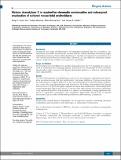Histone deacetylase 2 is required for chromatin condensation and subsequent enucleation of cultured mouse fetal erythroblasts
Author(s)
Ji, Peng; Yeh, Victor; Ramirez, Tzutzuy; Murata-Hori, Maki; Lodish, Harvey F
DownloadJi-2010-Histone deacetylase 2 is required for chromatin condensation.pdf (2.307Mb)
PUBLISHER_POLICY
Publisher Policy
Article is made available in accordance with the publisher's policy and may be subject to US copyright law. Please refer to the publisher's site for terms of use.
Terms of use
Metadata
Show full item recordAbstract
Background: During the final stages of differentiation of mammalian erythroid cells, the chromatin is condensed and enucleated. We previously reported that Rac GTPases and their downstream target, mammalian homolog of Drosophila diaphanous 2 (mDia2), are required for enucleation of in vitro cultured mouse fetal liver erythroblasts. However, it is not clear how chromatin condensation is achieved and whether it is required for enucleation.
Design and Methods: Mouse fetal liver erythroblasts were purified from embryonic day 14.5 pregnant mice and cultured in erythropoietin-containing medium. Enucleation was determined by flow-cytometry based analysis after treatment with histone deacetylase inhibitors or infection with lentiviral short harirpin RNA.
Results: We showed that histone deacetylases play critical roles in chromatin condensation and enucleation in cultured mouse fetal liver erythroblasts. Enzymatic inhibition of histone deacetylases by trichostatin A or valproic acid prior to the start of enucleation blocked chromatin condensation, contractile actin ring formation and enucleation. We further demonstrated that histone deacetylases 1, 2, 3 and 5 are highly expressed in mouse fetal erythroblasts. Short hairpin RNA down-regulation of histone deacetylase 2, but not of the other histone deacetylases, phenotypically mimicked the effect of trichostatin A or valproic acid treatment, causing significant inhibition of chromatin condensation and enucleation. Importantly, knock-down of histone deacetylase 2 did not affect erythroblast proliferation, differentiation, or apoptosis.
Conclusions: These results identify histone deacetylase 2 as an important regulator, mediating chromatin condensation and enucleation in the final stages of mammalian erythropoiesis.
Date issued
2010-09Department
Massachusetts Institute of Technology. Department of Biology; Whitehead Institute for Biomedical ResearchJournal
Haematologica
Publisher
Ferrata Storti Foundation
Citation
Ji, P. et al. “Histone Deacetylase 2 Is Required for Chromatin Condensation and Subsequent Enucleation of Cultured Mouse Fetal Erythroblasts.” Haematologica 95.12 (2010) : 2013-2021. © 2010 by Ferrata Storti Foundation.
Version: Final published version
ISSN
1592-8721
0390-6078